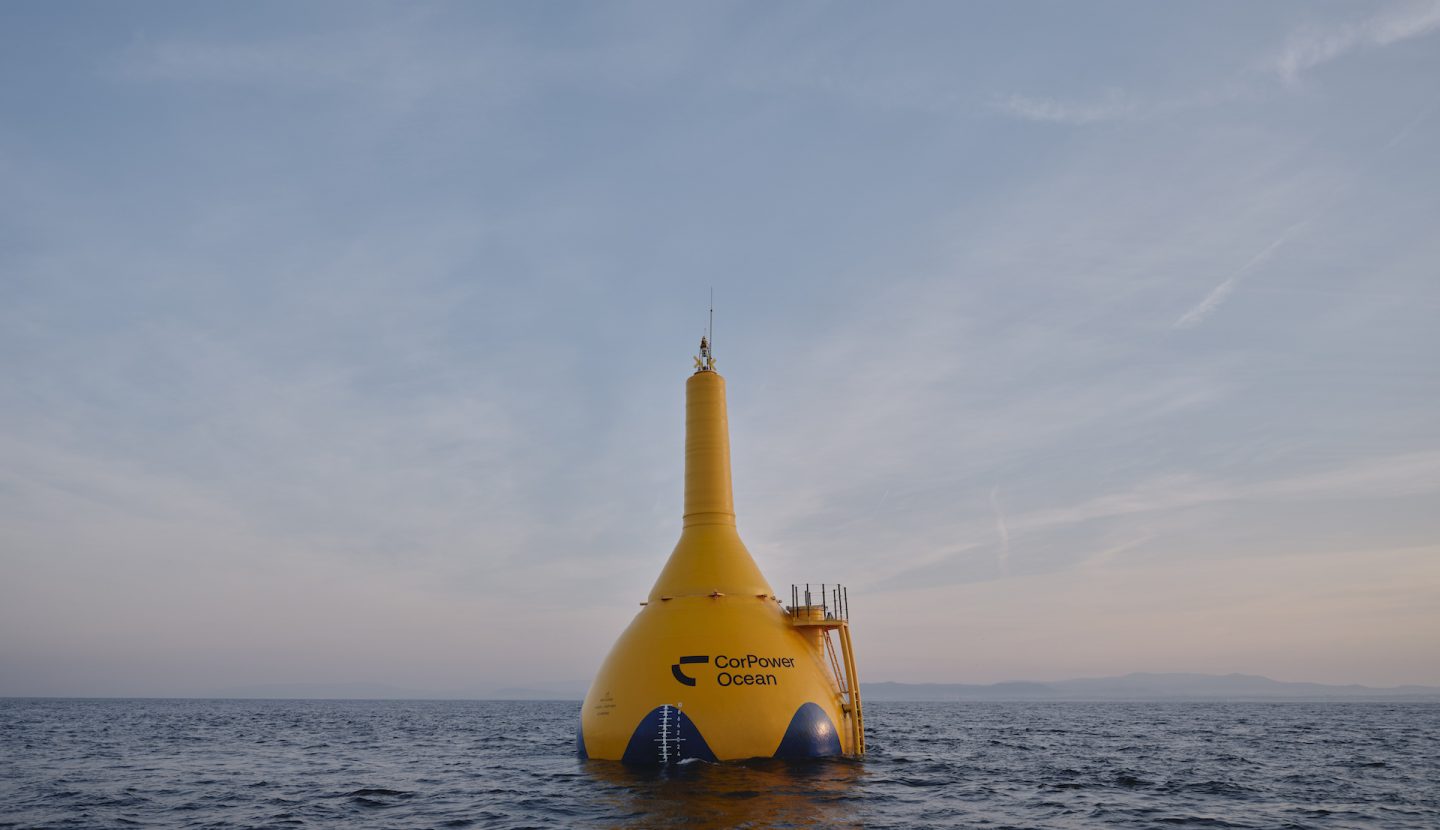CorPower Ocean’s C4 Wave Energy Converter (WEC) has completed the first cycle of the ocean commissioning program at the Agucadoura site in northern Portugal.
Now proven at commercial scale, at the exposed Atlantic test site, CorPower Ocean’s C4 device has demonstrated unique ability to tune and detune according to varying sea states, limiting response to extreme storm waves (up to 18.5m) while amplifying motion and power capture in regular waves using novel phase control technology.
The progression marks a crucial milestone for wave energy addressing the two major obstacles which have hampered commercial adoption to date – survivability and efficient power generation in normal ocean conditions.
The inflection point provides a firm signal of wave energy’s readiness for widescale adoption.
Since deployment in August 2023, all key aspects of the C4 system functions have now been successfully verified, including power export to grid, automated control and monitoring of the system as well as safe Operations and Maintenance (O&M) methods.
The collected data allowed calibration of the digital twin, an extensive numerical model used to predict the system behaviour. Measured motion and power output data from the machine operating with novel ‘WaveSpring’ phase control has slightly exceeded predictions by the digital twin for the machinery settings used. The first operational phase has been successfully concluded by disconnecting and towing the C4 device back to CorPower Ocean’s on-land base in Viana do Castelo for its first planned maintenance cycle. This demonstration of efficient O&M methods is a key goal of the C4 deployment program, to support scale-up to utility scale wave farms in the future.
After completing a first on-land check-up and maintenance cycle, C4 will be re-deployed at the Agucadoura site, and the demonstration program continued. Further details on results from the first phase of C4 operations is provided below.
Storm survivability
The survivability of the C4 WEC has been verified by weathering four major storms, with confirmation of the ability to re-commence operations and power export to the grid after each storm. To remind, CorPower C4 operates reliably through Babet and Aline storms (corpowerocean.com). The most energetic period was experienced during Nov 4th with storm Domingos sending swell to the site with wave heights up to 18.5m, reported by the Hydrographic Institute of Portugal as a historical record for the northern region. The CorPower C4 set a new storm survivability record (corpowerocean.com)
CorPower Ocean and its Pilot Access Program (PAP) partners have been able to verify the design principles for robust operation in extreme waves offered by the Survival mode of the CorPower C4 device. Operating in the detuned Survival mode, which is the natural state of the system, the device displayed very small response to incident waves despite the WEC hull becoming fully submerged during wave peaks on a regular basis during these storms. In the plot below, the blue curve shows the wave height estimated by onboard sensors during Nov 4th 2023, with waves up to 18.5m, where the green curve shows the machinery motion as measured by the gearbox encoders to a few decimetres at most.
The low machinery motion (range of decimetres) in these extreme waves confirms the effectiveness of the detuning principle used by the survival mode, with almost two orders of magnitude smaller machinery motion compared to the incident waves. The verification of very low response to storm waves is seen as one of the most important outcomes of the C4 ocean demonstration so far. Storm survivability has historically been one of the biggest challenges for wave energy devices.
Tuned operation
The survivability results can be compared to the measured data with C4 operating in tuned mode where up to 3m machinery motion has been observed in 1m incident waves. By activating the WaveSpring phase control technology the system starts oscillating in phase with the waves, which has been confirmed to strongly amplify the machinery response to the incident waves.
Tuning and detuning – a key feature for competitive wave energy
The ability to tune and detune the device according to ocean conditions, limiting the response to storms and amplifying the motion and power capture in regular waves, has been clearly demonstrated during the C4’s operational period in Agucadoura. The verification of the amplified motion and power capture by the phase control system is seen as a key outcome from the HiWave-5 demonstration project.
The tuning and detuning feature of CorPower Ocean’s WECs can be compared to wind turbines, where all modern turbines have a function to pitch the blades to alter the response to the wind conditions, limiting loads in storms while optimizing yield in regular conditions. We believe that adding such a similar function to wave energy is key for making it a reliable and competitive source of clean energy.
Power Performance
During this commissioning period the primary focus has been on verifying safe and reliable operations in all ocean conditions and to rigorously test each system function. The device has been operated with limited motion envelopes, providing extra safety margins by limiting the maximum allowed velocity and machinery stroke, and a robust but simple power output controller has been used to control the machine for most of the period. Power export up to 600kW peak power has been recorded.
The configuration of the electrical drive train has been found to limit peak power to about 600kW. During the first on-land maintenance cycle adjustments to the drive train are planned, aiming to increase power capacity towards 850kW. Due to the limited motion envelope and the power limitation to 600kW, tuned operation has been limited to moderate sea states during this first operational period. In the sea states where tuned operation could be verified the measured power output has slightly exceeded predictions from the digital twin using the same machinery settings.
Calibration of Digital Twin
The Digital twin (a detailed numerical model) of the system has been calibrated using the measured data on motion, power and internal machinery dynamics. The power conversion chain has been found to be accurately represented, with a close match between measured and simulated data, showing a typical goodness of fit in the range of 96-99%. This indicates that the Power Take Off components are accurately represented, with appropriate losses and efficiency maps. The hydrodynamic models have been found to slightly underestimate the power absorption from ocean waves into the WEC hull, which has resulted in measured motion and power in the ocean slightly exceeding predictions from the digital twin, for the measured sea states and the specific machinery settings used. Adjustments to non-linear correction functions of the hydrodynamic model can be expected going forward, based on the measured data and further informed by ongoing research on non-linear hydrodynamics in collaboration with leading academic groups.
Remote monitoring & control
The functions for remote monitoring and control have been verified from CorPower Ocean’s control centre. The C4 system was initially monitored 24/7 by operators, which could later be reduced to periodic check-ins as the commissioning program advanced and the supervisory system sent alarms to operators in case of events requiring attention.
The UMACK anchor
The first commercial scale UMACK anchor developed by CorPower Ocean in collaboration with European partners was installed at the Agucadoura site with a sandy seabed at 45m depth. Further details on this geotechnical innovation can be found here CorPower Oceans commercial scale UMACK anchor deployed. During the first operational cycle, with the C4 device connected to the UMACK anchor, stable station keeping was verified.
Operations & Maintenance (O&M)The methods for tow-out and connection of the C4 system was successfully demonstrated in August 2023 CorPower Ocean’s Wave Energy Converter Deployed in Portugal. After this, the methods for manned offshore access to the system could be reviewed and approved by third party safety reviewers, which has subsequently allowed CorPower Ocean technicians to access the machine on site to perform internal inspections and minor interventions.
Following completion of the test cases of the first commissioning phase, the methods for releasing and towing back the device for a planned on-land check-up and maintenance cycle have been successfully demonstrated. The release process involves remotely actuating a quick-connector located between the bottom of the mooring system and the UMACK anchor, allowing the device to surface. The operational period has provided valuable learning on O&M-methods towards efficient low-cost operations of utility scale wave farms in the future.
Next steps
The C4 system is now going through a planned on-land check-up sequence. Adjustments and upgrades will also be performed based on the learnings collected from the first cycle of operation. When completed the system will be redeployed in Agucadoura, and the system will be taken through a ramp-up phase to demonstrate full power capacity including further advancement in control methods. When the commissioning program has been completed, a Power Performance Assessment phase will be initiated following the IEC/TS 62600-100 standard.





